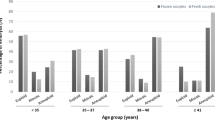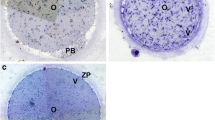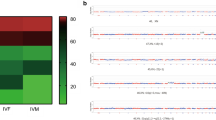Abstract
Purpose
The aim of this study is to evaluate the impact of oocyte vitrification on embryo development potential and to assess the chromosome abnormalities of blastocysts derived from fresh/vitrified-warmed oocytes to assure the safety of the oocyte cryopreservation technique.
Methods
In vitro matured oocytes derived from immature oocytes were retrieved from small follicles during IVF/intracytoplasmic sperm injection (ICSI) cycles were randomly divided into a fresh and vitrified-warmed groups. After intracytoplasmic sperm injection, the fertilization rate, embryo quality, and developmental status were compared between the two groups. Blastocysts derived from both groups were analyzed using the copy number variation (CNV)-seq technique to evaluate DNA abnormalities.
Results
The fertilization rate with ICSI and the cleavage rate were similar between the two groups. Among the vitrified-warmed group, there was a lower incidence of usable embryos on day 3 (16.42 vs. 28.57 %; P < 0.05) and a lower incidence of blastocysts (7.46 vs. 17.86 %; P < 0.05). However, the proportions of embryos that developed to blastocysts from the day 3 available embryos were similar between the two groups (62.5 vs. 45.45 %; P > 0.05). In the day 3 embryos, the proportion of >5 cell embryos in the fresh group was markedly higher than in the vitrified-warmed group (41.67 vs. 21.64 %; P < 0.05), and the proportion of embryos with ≧50 % fragments was not significantly different between the two groups (39.29 vs. 43.28 %; P > 0.05). The result of CNV-seq demonstrated that there was no difference in chromosomal abnormalities between the two groups (20 vs. 20 %).
Conclusions
Oocyte vitrification and the warming procedure diminished the embryo development potential before day 3, when embryo genomic activation started. The day 3 usable embryos derived from vitrified-warmed oocytes had the same potential for developing into blastocysts. Vitrification and the warming procedure did not increase the chromosome abnormalities of the blastocysts. Oocyte vitrification is a safe technique for those patients who have no other options, although the oocyte efficiency may be diminished after the vitrified-warmed procedure.
Similar content being viewed by others
References
Grifo JA, Noyes N. Delivery rate using cryopreserved oocytes is comparable to conventional in vitro fertilization using fresh oocytes: potential fertility preservation for female cancer patients. Fertil Steril. 2010;93(2):391–6.
Cobo A, Remohi J, Chang CC, Nagy ZP. Oocyte cryopreservation for donor egg banking. Reprod Biomed Online. 2011;23(3):341–6.
Shaw JM, Oranratnachai A, Trounson AO. Fundamental cryobiology of mammalian oocytes and ovarian tissue. Theriogenology. 2000;53(1):59–72.
Parmegiani L, Cognigni GE, Bernardi S, Cuomo S, Ciampaglia W, Infante FE, et al. Efficiency of aseptic open vitrification and hermetical cryostorage of human oocytes. Reprod Biomed Online. 2011;23(4):505–12.
Rienzi L, Romano S, Albricci L, Maggiulli R, Capalbo A, Baroni E, et al. Embryo development of fresh 'versus' vitrified metaphase II oocytes after ICSI: a prospective randomized sibling-oocyte study. Hum Reprod. 2010;25(1):66–73.
Cobo A, Meseguer M, Remohi J, Pellicer A. Use of cryo-banked oocytes in an ovum donation programme: a prospective, randomized, controlled, clinical trial. Hum Reprod. 2010;25(9):2239–46.
The practice of Committees of the American Society for Reproductive Medicine and the Society for Assisted Reproductive. Mature oocyte cryopreservation: a guideline. Fertil Steril. 2013;99(1):37–43.
Liang D, Peng Y, Lv W, Deng L, Zhang Y, Li H, et al. Copy number variation sequencing for comprehensive diagnosis of chromosome disease syndromes. J Mol Diagn. 2014;16(5):519–26.
Wang L, Cram DS, Shen J, Wang X, Zhang J, Song Z, et al. Validation of copy number variation sequencing for detecting chromosome imbalances in human preimplantation embryos. Biol Reprod. 2014;91(2):37. 1-8.
Fan J, Wang L, Wang H, Ma M, Wang S, Liu Z, et al. The clinical utility of next-generation sequencing for identifying chromosome disease syndromes in human embryos. Reprod Biomed Online. 2015;31(1):62–70.
Fiorentino F, Biricik A, Bono S, Spizzichino L, Cotroneo E, Cottone G, et al. Development and validation of a next-generation sequencing-based protocol for 24-chromosome aneuploidy screening of embryos. Fertil Steril. 2014;101(5):1375–82.
Fiorentino F, Bono S, Biricik A, Nuccitelli A, Cotroneo E, Cottone G, et al. Application of next-generation sequencing technology for comprehensive aneuploidy screening of blastocysts in clinical preimplantation genetic screening cycles. Hum Reprod. 2014;29(12):2802–13.
Russell JB. Immature oocyte retrieval combined with in-vitro oocyte maturation. Hum Reprod. 1998;13(Suppl3):63–70.
Sun Y, Feng Y, Zhang A, Lu X, Niu Z, Gu R. Frozen-thawed embryo transfer cycles in China: clinical outcomes of two and three multicellular embryos transfers. J Assist Reprod Genet. 2012;29(5):417–21.
Kuwayama M. Highly efficient vitrification for cryopreservation of human oocytes and embryos: the Cryotop method. Theriogenology. 2007;67(1):73–80.
Van den Abbeel E, Balaban B, Ziebe S, Lundin K, Cuesta MJ, Klein BM, et al. Association between blastocyst morphology and outcome of single-blastocyst transfer. Reprod Biomed Online. 2013;27(4):353–61.
Liang D, Lv W, Wang H, Xu L, Liu J, Li H, et al. Non-invasive prenatal testing of fetal whole chromosome aneuploidy by massively parallel sequencing. Prenat Diagn. 2013;33(5):409–15.
Forman EJ, Li X, Ferry KM, Scott K, Treff NR, Scott Jr RT. Oocyte vitrification does not increase the risk of embryonic aneuploidy or diminish the implantation potential of blastocysts created after intracytoplasmic sperm injection: a novel, paired randomized controlled trial using DNA fingerprinting. Fertil Steril. 2012;98(3):644–9.
Trokoudes KM, Pavlides C, Zhang X. Comparison outcome of fresh and vitrified donor oocytes in an egg-sharing donation program. Fertil Steril. 2011;95(6):1996–2000.
Lei T, Guo N, Liu JQ, Tan MH, Li YF. Vitrification of in vitro matured oocytes: effects on meiotic spindle configuration and mitochondrial function. Int J Clin Exp Pathol. 2014;7(3):1159–65.
Braude P, Bolton V, Moore S. Human gene expression first occurs between the four- and eight-cell stages of preimplantation development. Nature. 1988;332(6163):459–61.
Zhang P, Zucchelli M, Bruce S, Hambiliki F, Stavreus-Evers A, Levkov L, et al. Transcriptome profiling of human pre-implantation development. PLoS One. 2009;16;4(11):e7844.
Vassena R, Boué S, González-Roca E, Aran B, Auer H, Veiga A, et al. Waves of early transcriptional activation and pluripotency program initiation during human preimplantation development. Development. 2011;138(17):3699–709.
Wang Q, Latham KE. Translation of maternal messenger ribonucleic acids encoding transcription factors during genome activation in early mouse embryos. Biol Reprod. 2000;62(4):969–78.
Schramm RD, Paprocki AM, VandeVoort CA. Causes of developmental failure of in-vitro matured rhesus monkey oocytes: impairments in embryonic genome activation. Hum Reprod. 2003;18(4):826–33.
Author information
Authors and Affiliations
Corresponding author
Additional information
Capsule
Oocyte vitrification diminishes embryo development potential but does not increase chromosomal abnormalities of blastocysts. It is a safe technique for those patients who have no other options.
Rights and permissions
About this article
Cite this article
Sun, Y., Gu, R., Lu, X. et al. Vitrification of in vitro matured oocytes diminishes embryo development potential before but not after embryo genomic activation. J Assist Reprod Genet 33, 231–236 (2016). https://doi.org/10.1007/s10815-015-0637-5
Received:
Accepted:
Published:
Issue Date:
DOI: https://doi.org/10.1007/s10815-015-0637-5




